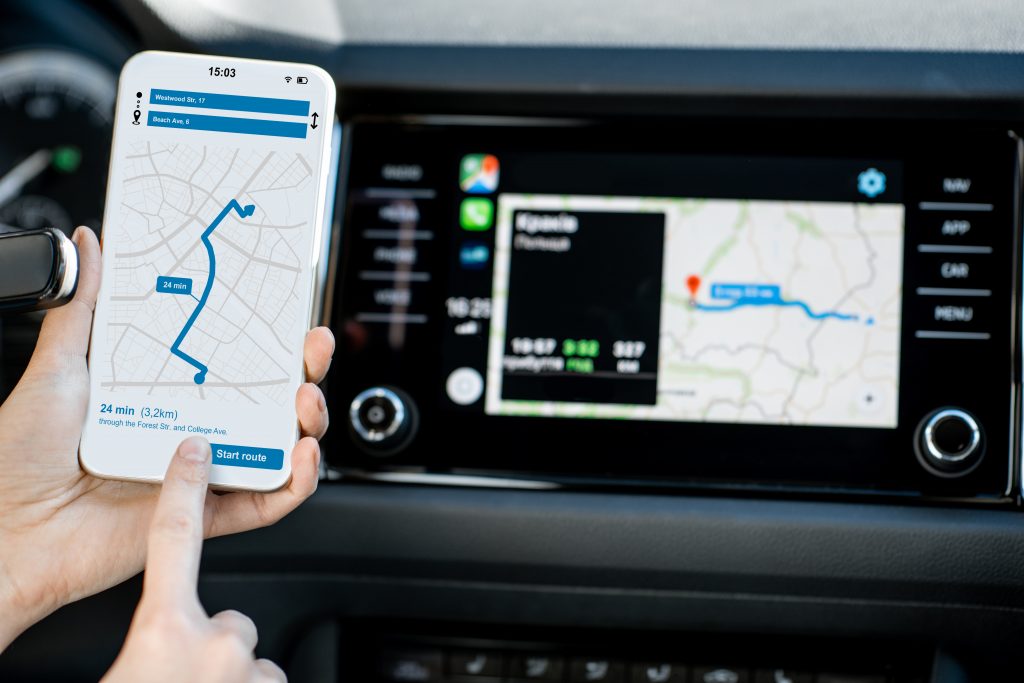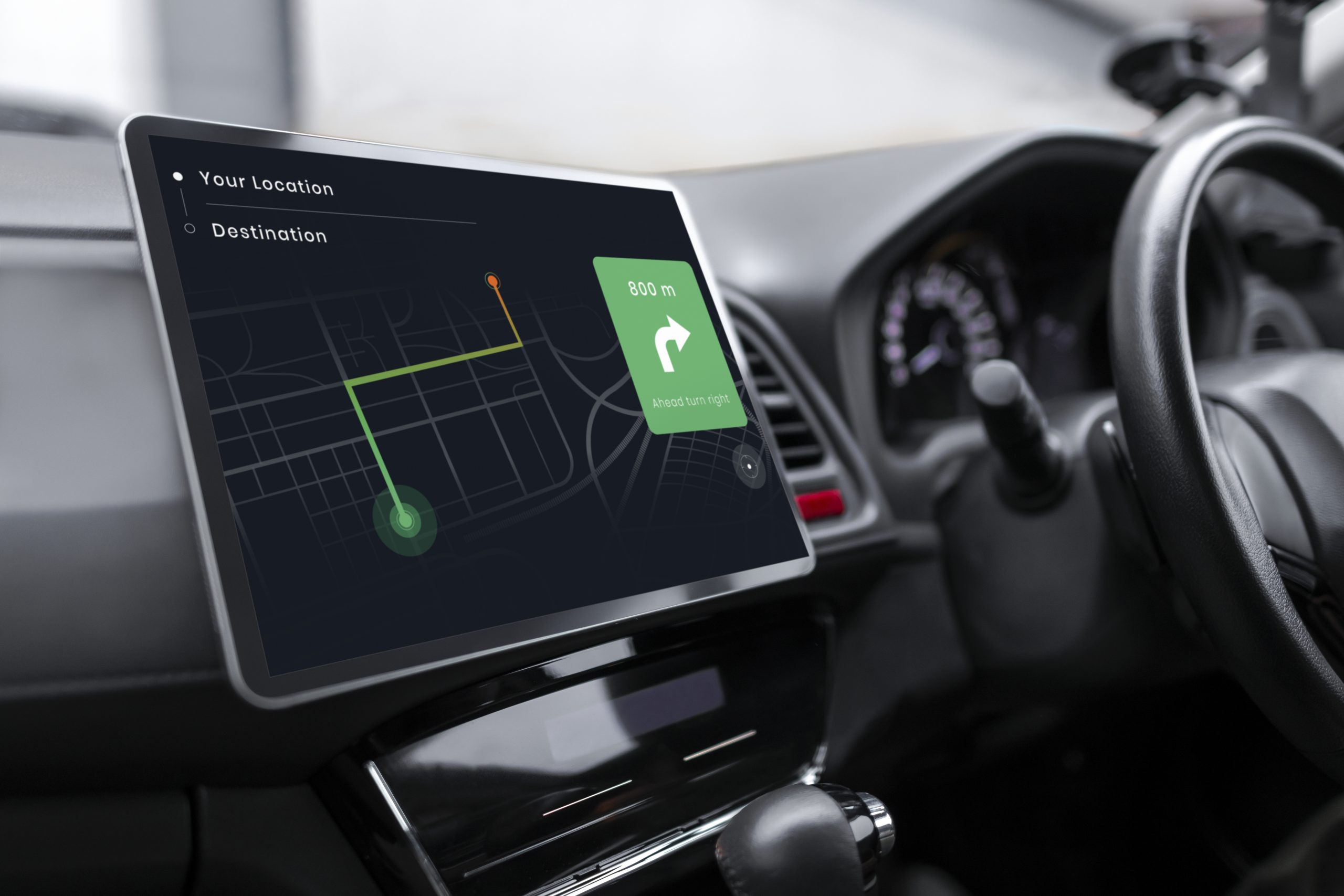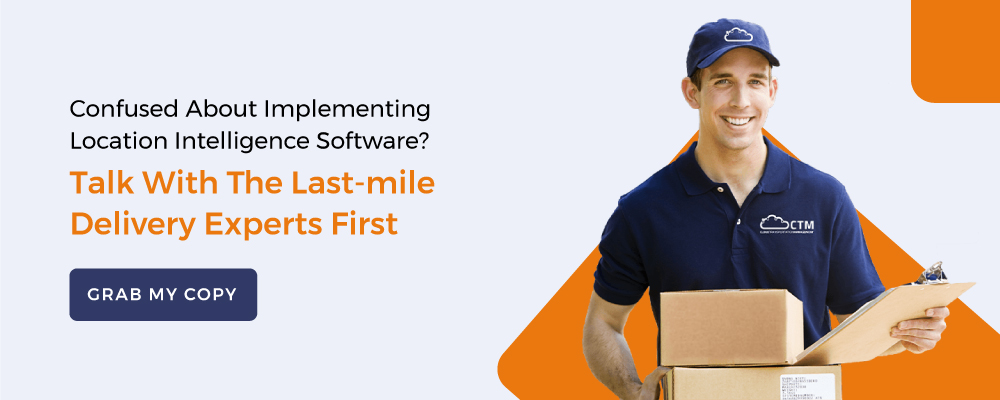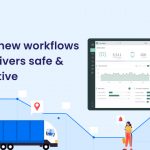
Location Intelligence- Powering Route Optimization Software to New Heights
Google, tracks our movements and presents us with a monthly summary of where we have been each day of the previous month. Why, even Uber, Rapido, and their ilk, our very own ride-hailing apps, leverage our location data to bring superior services to our doorsteps. The online retail chains of the world a la Amazon, rely upon capturing locational data to deliver faster, better, and more informatively to us. Fleet management companies use location intelligence in their route optimization software aiding their efforts to execute on-time, informed, bespoke services, and ensure the safety & productivity of their fleet and drivers. What is Location Intelligence, and how is Route Optimization Software powering fleet owners to stay ahead of the game is the subject of our blog.
Location Intelligence- What Is It?
Location intelligence (LI) is derived from the visualization and analysis of geospatial (location-specific) data. Such analysis enables comprehension, insight, projection, and decision-making. By superimposing geographic, demographics, traffic, and weather data onto a smart map or dashboard, organizations can infer where an event occurred, and understand why. Today, organizations are depending on geographic information system (GIS) technology to generate location intelligence.
With a host of devices connected to the Internet of Things (IoT) and the Internet of Things That Move (IoTM), think tanks gain access to vast amounts of business and geospatial data. Viewing all this in the locational context, be it on a smart map, app, or dashboard—provides unique insights which unravel hidden relationships, patterns, and trends, yielding a competitive business advantage.
Location Intelligence Enriching Route Optimization Software?
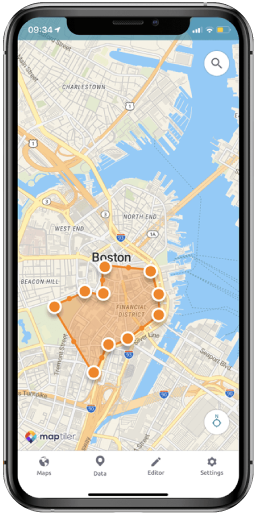
Let us look at the broad strokes of how Location Intelligence Route Optimization Software is working to take route optimization to new heights.
Traffic Congestion
This often delays the deliveries of services and products to customers. Location intelligence (generating real-time data on traffic and signals) enables businesses to use the same in their route optimization software to decide the ideal periods for movement, and alternative routes, allocate jobs to the nearest agents, and monitor last-mile deliveries.
Timely Deliveries

Location Intelligence powers more efficient route optimization software and facilitates timely deliveries to take place thus minimizing complaints and increasing the customers’ trust in your brand. It also increases agent productivity by enabling him to achieve more over shorter durations. Data from route optimization software equips stakeholders at each workstation to better anticipate, receive, and dispatch items well in advance- thus impacting timelines positively.
Cost Efficiency
Location intelligence, by throwing up the shortest routes between pick-up and drop destinations increases cost efficiency. Also, the positive impact of Location Intelligence on route optimization software enables fleet management companies to save 20-30% on fuel expenses and increase their output twofold, thereby enhancing cost-efficiency.
Route Tracking Software
![]()
Tracking goods carriers is another value-add of location intelligence to route tracking software. In case of accidents, this feature allows the fleet manager to direct help immediately to the location, thus saving money on medical expenses, insurance payments, vehicle repairs & replacement, and preventing customer loss. Location Intelligence-powered route tracking software also considers factors like driver tiredness, weather conditions, roadblocks, and constructions. Location Intelligence in route optimization software, by aiding preparation for such eventualities, actually reduces the chances of an accident. Besides this, it also offers protection against vehicle theft, increases the life of vehicles by enabling timely preventive maintenance, and keeps drivers safe.
Discovering Hidden Data
Delivery route planning software via its Machine Learning capabilities uncovers data about delivery processes that manual logistics planning cannot. For instance, Location Intelligence can unearth through data which factors enable some geographies to yield better outcomes for a business compared to others.
Overcoming Supply Chain Challenges Using Delivery Route Optimization Software
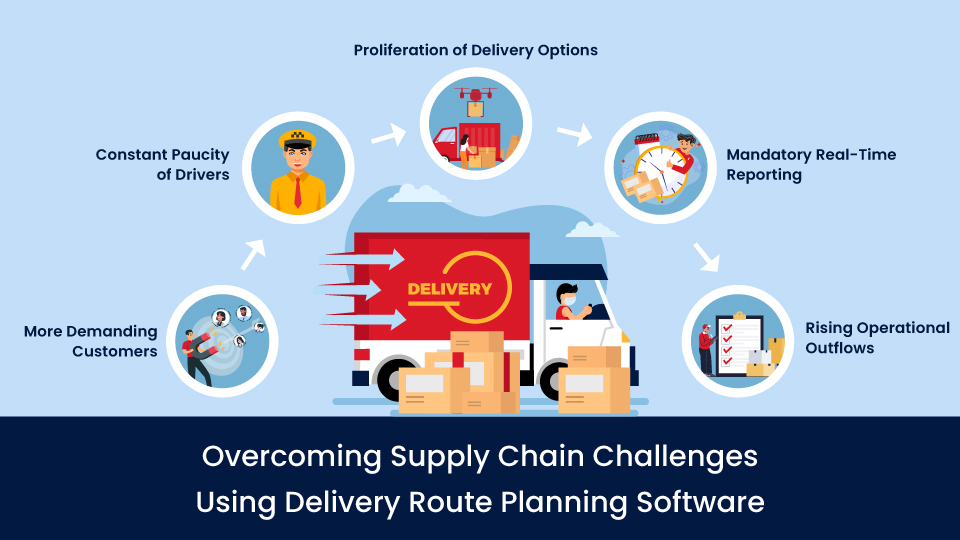
Traditionally transportation businesses have been plagued by a perennial shortage of drivers, lack of infrastructure, skyrocketing fuel bills, poor capacity utilization of goods carriers, and high transit times. Though these pain points still exist, delivery route planning software, through efficient planning of their delivery schedules and routes, has made the lives of the members of supply chains much easier. Let’s move on to a detailed discussion of these challenges and how route optimization software can solve them.
Challenge # 1- More Demanding Customers
Today’s customers expect seamless order execution, absolutely transparent & on-time deliveries, real-time communication, and immediate reporting on any deviations.
By integrating delivery route planning software with a vehicle tracking system, businesses gain real-time visibility of the fleet’s status vs plan. Deviations from the planned route or schedule are immediately visible, and the customer can be proactively intimated. The software enables one to reduce route planning time, accurately predict ETAs, and improve the quality of customer interaction.
Challenge # 2- Constant Paucity of Drivers

Legislation, such as the electronic logging device (ELD) mandate and the Federal Motor Carrier Safety Administration (FMCSA) Hours of Service (HOS) rule (in the US), capping the duration and mileage truckers can drive has caused many drivers to feel disgruntled at their reduced earning capacity. ELD has resulted in some drivers quitting the industry forever.
While delivery route planning software cannot alter the perception of trucking as an occupation, businesses can motivate drivers by focusing on non-monetary benefits like food breaks, overnight stops, or closing times in the route scheduling process. For the money angle, the drops per driver can be maximized with more efficient planning to optimize per trip profitability.
Bonus Read- How Fleet Maintenance Management Software Helps Drivers In Risk Diminution?
Challenge # 3- Proliferation of (Home) Delivery Options

Transportation companies into home deliveries face multiple supply challenges, like:
- Increasing demand for express order fulfillment process
- More e-commerce orders
- Demand for multiple shipping options- instant, same-day, two/three/five-day
- Point of delivery- home, workplace, secure locker, click and obtain from a specific location
With home delivery becoming an increasingly complex operation, one needs an end-to-end order fulfillment system that affords visibility of the location of every item in the delivery process.
Enter fulfillment and delivery route planning software, a delivery route planner, as it is known in the supply chain parlance. Such specialized software enables you to:
- Present customers with cost-efficient shipping options
- Constantly optimize delivery routes as orders keep being logged in, balancing client requirements with delivery constraints
- Offer more accurate ETAs, thereby raising customer service levels and upgrading the overall delivery experience
- Track visually the progress of your shipments’ from hub to client door
Challenge # 4- Mandatory Real-Time Reporting

At every point in the supply chain, there is a clamor for real-time reporting to boost service levels and operational efficiency. Customers are insisting upon improved visibility of their orders and the facility to track the status of their orders digitally.
With the rising use of smart devices, mainly the IoT/IoTM variety, across the supply chain—be they devices monitoring the progress of a pallet on a ship or a truck —the movement of in-transit material can now be tracked accurately. This dovetails seamlessly with delivery route planning software and enables businesses to swiftly clear distribution centers, and leverage the last two benefits mentioned under Challenge # 3.
With such a hybrid route optimization software, one will be able to:
- Receive alerts whenever your trucks stray from the planned route
- Receive updates on delivery delays, enabling you to preemptively inform the customer accordingly
- Execute dynamic routing depending upon road and weather conditions, aided by real-time interaction between fleet managers and drivers
- Track and Report on KPIs, e.g., total deliveries completed and on-time percentage
Challenge # 5- Rising Operational Outflows
Fulfilling rising customers’ expectations pushes up software, hardware, personnel, and process expenses. However, deploying the right delivery Route Optimization Software enables more efficient planning of their transportation processes and counterbalances such operational costs by:
- Shortening routes and reducing mileage traversed, cutting down energy and vehicle maintenance costs
- Optimizing resources by increasing the number of daily drops per driver
- Expanding the customer base on account of a better all-round experience, with better visibility and more delivery options
- Allowing enhanced payments to regular drivers and concurrently reducing the number of more expensive contract drivers
Related read: Struggling with Last Mile Delivery Logistics? – Here’s a Complete Guide
AI-Based Route Optimization As a Last-Mile Delivery Solution
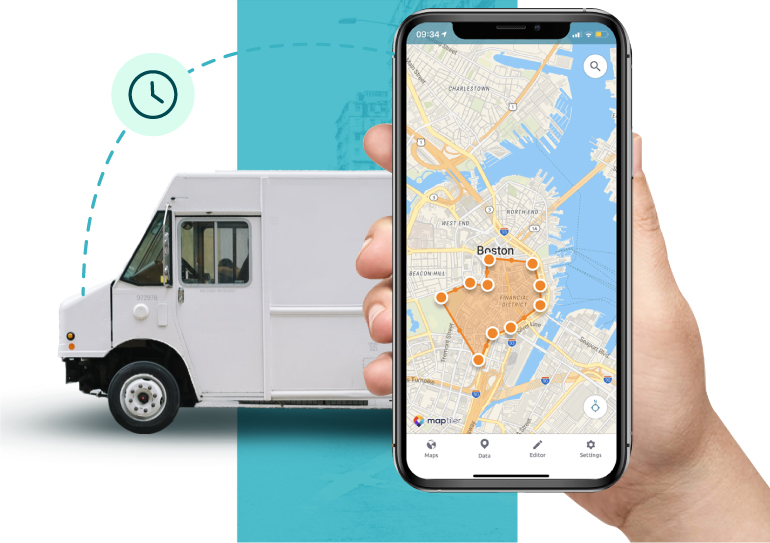
Enough of today’s technology, it’s time to do some crystal gazing into the future of Location Intelligence and route optimization software.
GIS Data and AI-Based Route Optimization
Logistics companies appreciate the value of speed, efficiency, and visibility since their valued customers expect faster delivery and real-time visibility into where their shipments are in the delivery chain. An unprecedented combination of technologies, location intelligence of a geographic information system (GIS) in tandem with sophisticated AI algorithms is poised to provide companies with precisely that kind of insight.
This will enable companies in the near future to fine-tune their knowledge of road networks, and improve their scheduling capabilities, thereby saving time & money while increasing customer satisfaction. Let’s examine a couple of examples.
AI-Powered Road Snapping
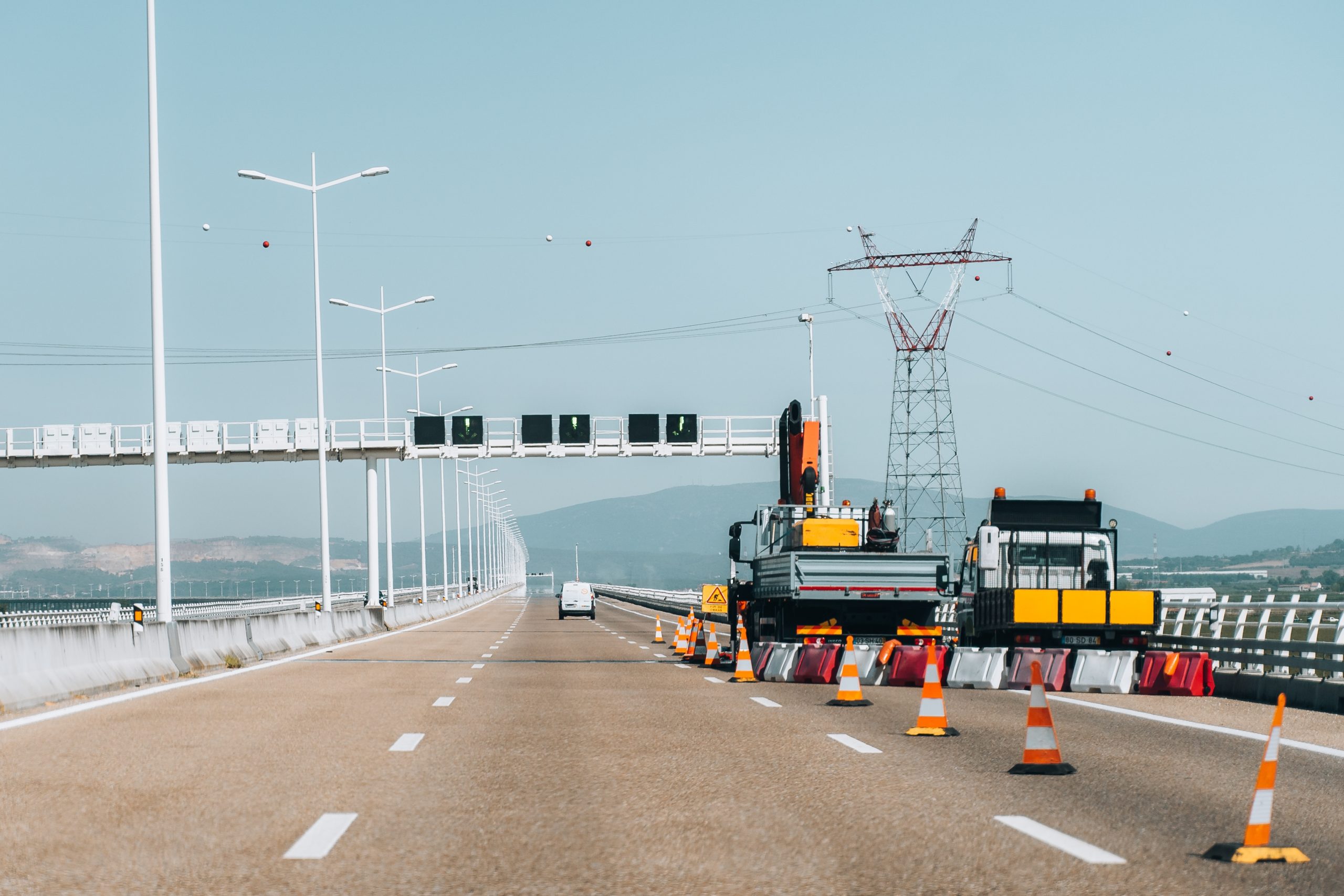
The first example is a combined AI-GIS tool called road snapping that upgrades companies’ knowledge regarding road networks. This becomes particularly relevant for remote areas with unmapped roads, densely packed areas with some roads closed for construction and others just opened. Daily haulers need to know in real-time. Otherwise, navigation goes haywire, and both the company & its customers end up losing valuable time, fuel, and money.
Road Snapping is a unique blend of IoT data, GIS-driven location intelligence, and AI-powered algorithms which prevents such losses. Leveraging millions of GPS data points from the company’s delivery vehicles, the road-snapping software finds out unmarked/impassable roads and updates the GIS technology so that companies are always ‘in the know’.
ETA- A Last-Mile Delivery Solution
Being able to predict accurate ETAs is a critical success factor in achieving higher efficiency, profitability, and customer satisfaction. This brings us to the second example, ETA, a tool running on a similar combo of IoT data, location intelligence, and AI. This runs on a neural network—an AI engine designed to analyze numerous historical data points for every delivery route, like the start and endpoints, weekends or holidays, vehicle type, the merchandise, and the road surfaces covered. With its immense computing power, ETA uses this massive data pool to churn out accurate ETAs!
Connected Logistics
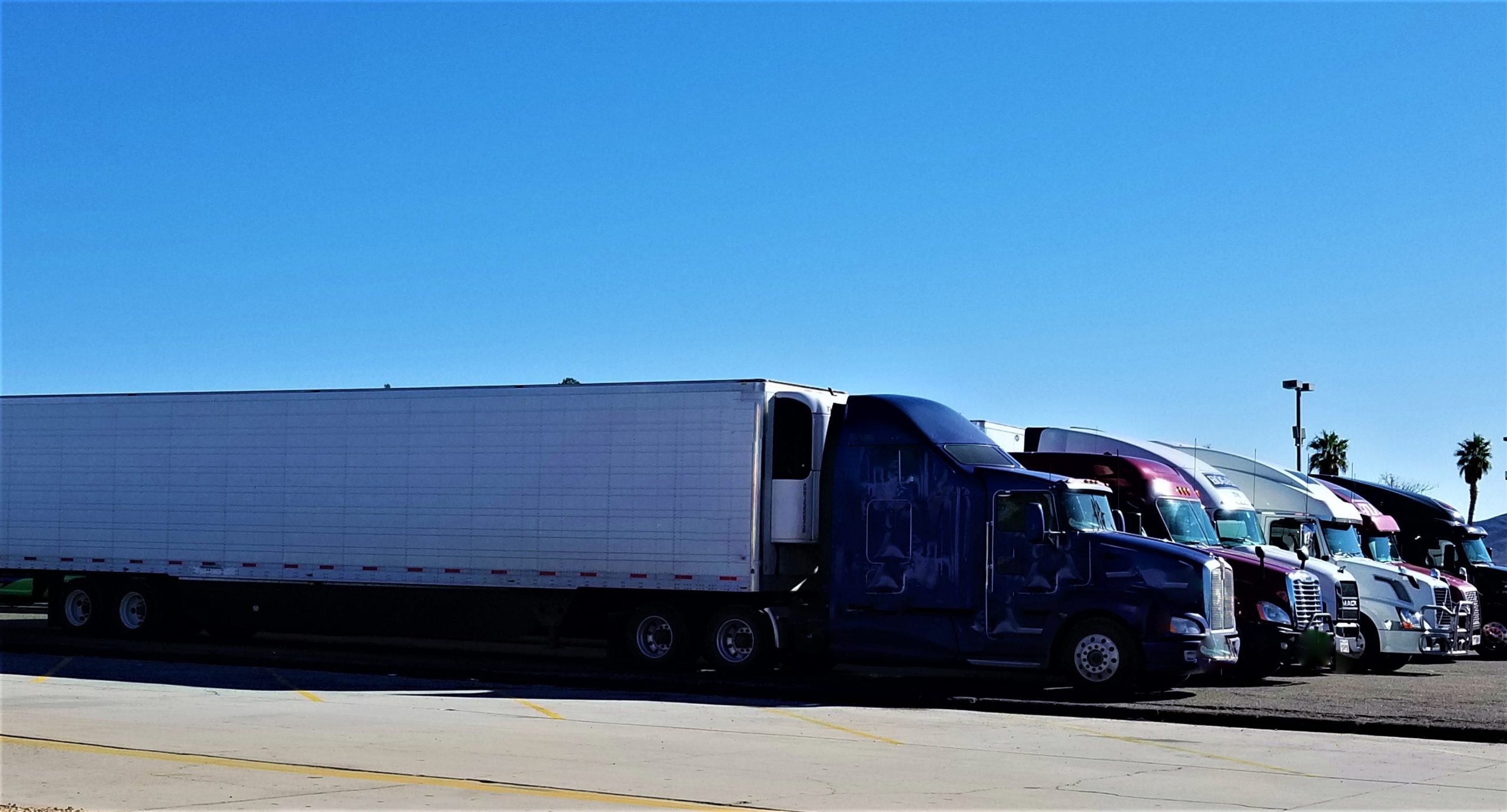
This brings us to the next big innovative concept of the future- Connected Logistics. Connected Logistics is the mega combination of optimizing logistics management & route optimization solutions while leveraging the Internet of Things & Machine Learning capabilities. Sounds like jargon? Let’s see how it works in the logistical world.
Shipments move on long-haul trucks are fitted with tracker sensors that have weather, temperature, and location tracking abilities. This enables real-time tracking of shipments while monitoring the merchandise’s quality and the prevailing weather conditions. This location intelligence provides inputs to send vehicles via ideal routes- the most efficient, traffic-light, time-distance-cost optimized paths.
Thus the efficiency of each link of the supply chain is increased by the internal workings of algorithms within efficient last-mile delivery solutions. Such software learns from delivery associates and vehicle movements and stores this learning as historical analytics which it uses to continually improve through iterations.
The net result, end-consumers get their requirements on time at their preferred locations.
On-premise vs Cloud-based SaaS Solutions and Scalability
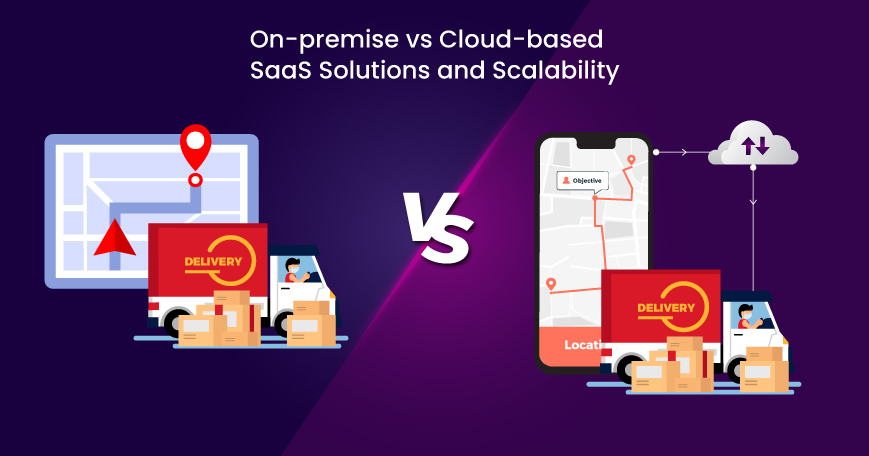
Route optimization software requires computing routes swiftly and scaling seamlessly.
For On-premise solutions the only method of additional route creation (e.g. for spikes
in orders) is by adding extra servers, which can be prohibitively expensive and labor-intensive.
A caveat here, before leaping into AI-powered SaaS solutions for route optimization it is imperative to check whether the vendor has a scalable cloud architecture.
The vendors should be able to demonstrate how their platforms manage a hundred/thousand/ten thousand trucks, —if the software comes to a grinding halt after
a few thousand trucks load, it’s not scalable.
Implementing In-App Route Optimization
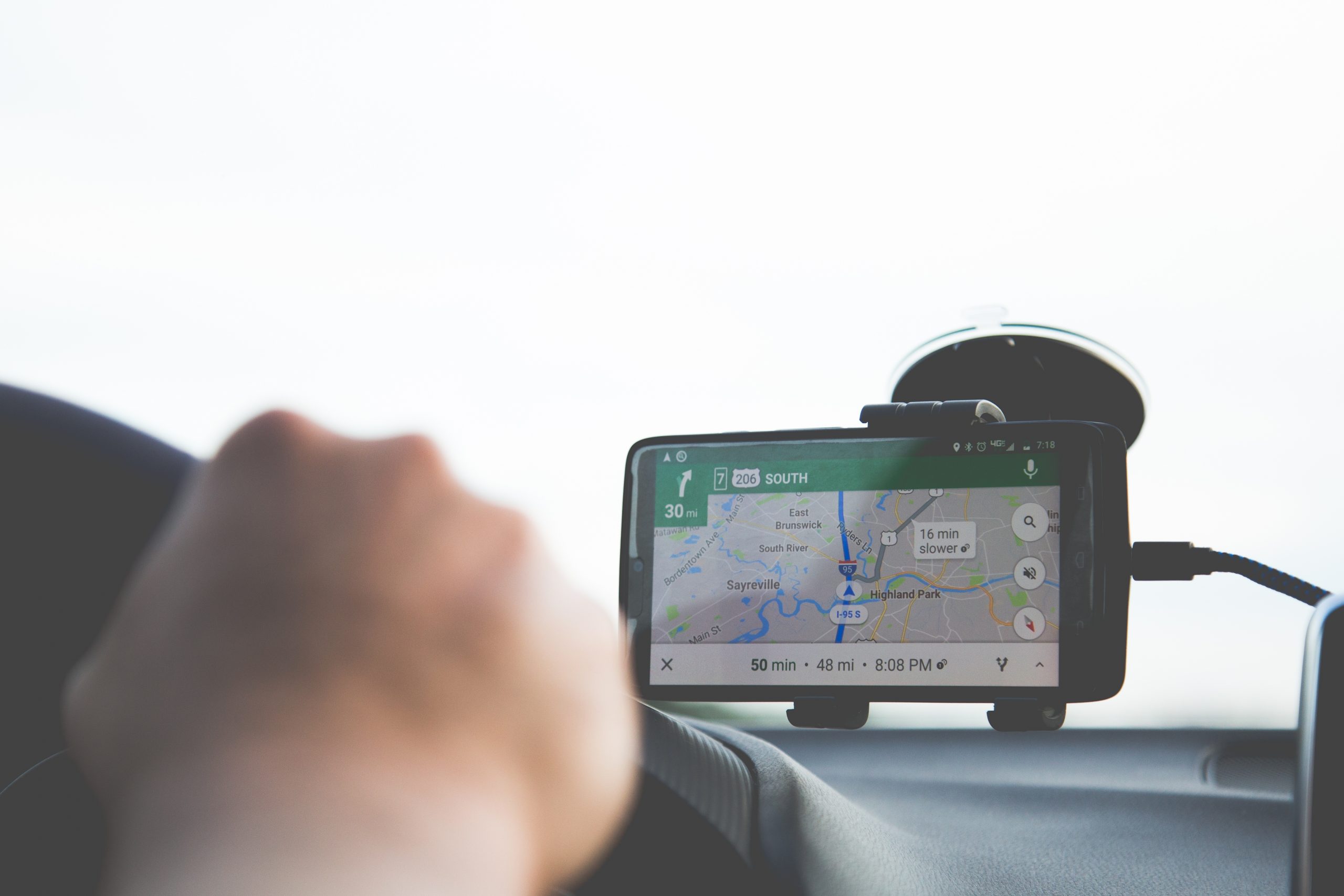
Before we plunge into our last segment about route optimization apps it’s important to distinguish between two oft-confused terms- API and App. API is the acronym for Application Programming Interface, which is a software intermediary that enables two applications to communicate with each other. Each time you use an app you’re using an API. Both APIs & Apps provide some form of connectivity, but while APIs are used by apps, the apps themselves are used by humans.
App developers can implement In-app route optimization through ready-made route planning software like Onfleet, a SaaS variety that has a ready yet stand-alone platform and an API that can automatically generate delivery routes and create delivery reports. Another offering is Route4me, which is multi-functional, spanning route planning, voice-based navigation, user notifications, data analytics, etc.
The developers also have the option of, creating a customized in-app route planner from scratch, though taking the white label route is often the more efficient option.
In-App Route Planning During Fleet Management
Route planning for a fleet requires factoring in data like vehicle capacity, timelines, real-time traffic updates, etc., These are detailed below:
Real-Time Traffic
App developers must make sure that the algorithms can generate results given data on roadblocks, traffic- jams, and similar impediments on the route during route creation.
Schedule Optimization
A route planning app must also consider delivery schedules and time frames to facilitate efficient deliveries.
Real-Time Delivery Tracking
App developers have to make sure delivery personnel understand how the route is followed in real-time. This can minimize errors in delivery and aid rescheduling of the same in the interest of speed.
Vehicle Capacity
Good route planning apps should have algorithms capable of handling vehicle routing problems.
Forbidden zones
The app should be capable of considering forbidden areas on its map and avoid including those areas in the user’s routes.
ELD Mandate
Managers using the app should be able to monitor drivers’ efficiencies on the route and allow them to set limits on their working hours.
Analytics and Reporting
The apps should be able to follow routes and help drivers to compare their performance and client satisfaction over time.
Integrating Ready-Made Route Planning APIs

We have already seen that robust route planning needs data inputs like traffic updates, maps, and the user’s destinations. There are APIs available off-the-shelf in the maps and navigation market with all the necessary bells and whistles which are easy to integrate during app development.
Google Maps Platform
Google Maps Platform is a cloud-based product for logistical automation. It provides app developers with optimal routes, after factoring in vehicle types, including multi-stop binges, traffic groups, no. of turns, and impediments.
Mapbox
Mapbox Navigation’s multiple API – powered service is perfect for App developers to execute route-planning and wayfinding using real-time traffic updates. It helps apps to optimize routes, undertake directional navigation, and beat roadblocks.
Building Route Planning Capability Into Your App from Scratch
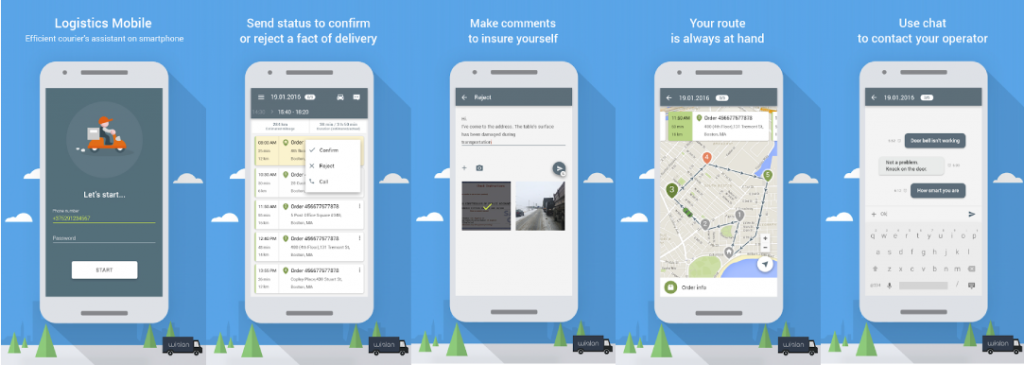
Now we come to the lesser taken path to app development. Developers can tailor-make route planning algorithms from scratch, ensuring unique customizations, incorporating bespoke rules, and designing routes that cover the specific use-cases of the clients’ businesses.
ML-powered algorithms like ant colony optimization assist the planning of routes in an optimized manner. It locates the shortest and most efficient route much like ants do and hence the name.
App developers need to deliver a system for organizing route plans, scheduling deliveries and allowing manual route interventions if required.
We’ve traversed the whole gamut of concepts related to route optimization software. Then what is an In-app route planner? It’s an application-based technology that connects destinations to the app holder’s recent location.
Such In-app route optimizers have benefits that mirror those of route optimization software. Businesses apart, such apps can transform the lives of even individuals like you and me!
Related read: how IoT is influencing the transportation and logistics industry
Benefits of Route Planning Software

- Cost-effective routes at a click enable trouble-free location of the exact address commuters wish to reach. Business benefits have been discussed earlier.
- Shorter distances to cover yields savings on fuel, and vehicle maintenance, and minimizes accidents for both businesses and individuals.
- Better trip planning informs the rider about the shortcut way, traffic, dead ends, and landmarks. Both laypeople and delivery personnel can identify the ideal route without wasting time.
- Superior productivity by being able to optimize routes, plan compact trips, and save time- both businesses and the common man benefit.
- Enable more jobs per day– be they household errands or delivery jobs.
Technical Features
Specific features to be incorporated while designing the technology for an in-app route planner:
1. Optimized Route Map
This enables drivers to select customized routes depending on the curviness, weather, and land elevation. These apps also display data on temperature, weather warnings, surface conditions, wind, and humidity.
2. Voice-Guided Route Planning App
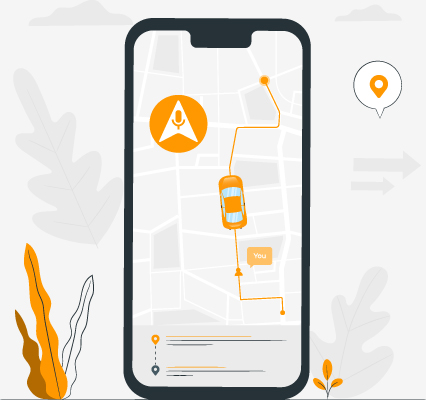
With this hands-free and voice-guided navigation feature, the rider will be able to avoid accidents by focusing attention only on the path. This feature also updates drivers about the weather and accident-prone areas ahead.
3. Enhanced Graphical User-Interface
This feature empowers the users to interact with devices having graphical icons. Audio indicators and graphics enable riders to use the exact specifications easily.
4. Important Stops And Requirements
This feature signals the driver about petro pumps, eating joints, restrooms, hotels, etc., coming up. Instead of being forced to switch to another location-based app to look for important stops. experienced development partners ensure that they create a multi-functional app.
5. Save And Share
In response to the recent trend of saving and sharing information among mobile users, this feature enables travelers to save and share the most-used routes, important locations, restaurants, medical shops, etc.
6. User-Friendly Interface
Graphical or text-based, if the interface design is not user-friendly, drivers will find it tough to use the app. Hence, developers try to implement a user-friendly interface to popularize the app among travelers.
End Credits
Do you have an on-demand business idea like Uber or Amazon? By investing in white-label, route optimization apps, you avoid reinventing existing software and technology and increase the time focusing on your business. The logistics app development experts of AllRide can hand-hold you with unique location intelligence software. Don’t lose any more time.



